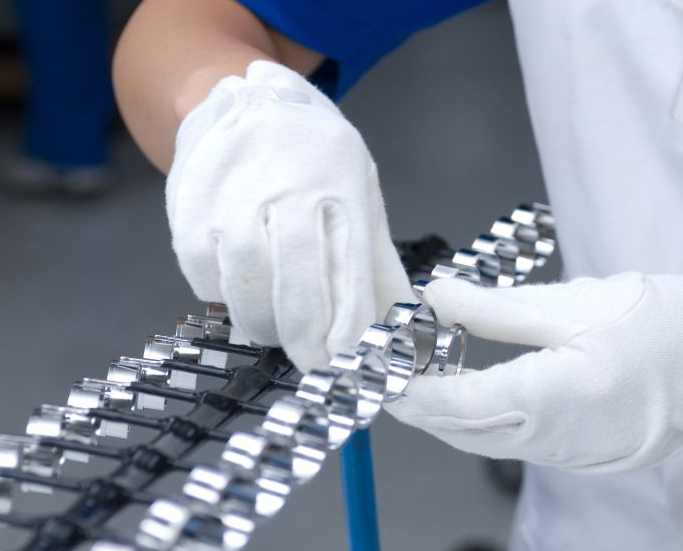- Basic Info
- Equipment
- Technology & Products
- History, Philosophy & Quality
- Map / HQ
The story of jigs that affect quality
Industry
---
Specifications
- Materials: ---
- Lots: ---
- Precision: ---
Conventional technologies/differences from other companies
Jigs for plating are used to secure products (object) to be plated, to make them easier to work with and to perform plating, pretreatment, and convey.
We have about 400 types of jigs, and the types increase each time a product with a new shape is plated.
Among the troubles related to plating, there are many problems caused by jigs.
1. Sheet-shaped, pressed products
Plating is not possible for products that have no hanging position. It should be catched on something.
Normally, sheet-shaped products are plated by sandwiching the top and bottom. The part in contact with the jig is uncovered, and electricity is taken by the jig around it, so the plating becomes thinner and the color is lighter, the base is visible, and there is no gloss compared to other parts. (jig mark)
Also, since it is sandwiched, it may be deformed if the product is thin.
2. Cup-shaped, bowl-shaped, and cylindrical products
With products with such shapes, air pools are formed and that part tends to be uncovered. It is necessary to make an air outlet to secure the product. If it is needed to wrap the plating around the inside of the cylinder, it is necessary to further turn the cylinder side of the product toward the anode. In addition, it may be necessary to install a supporting anode to rotate the inside part.
If there are no holes for securing, it is necessary to attach a jig to the outside or inside the cylinder, which may cause jig marks or scratches.
3. Products with complex unevenness
In such products, air may collect in concave part, the film thickness of the convex part may increase, and browning(burnt) may occur due to current concentration. It is necessary to devise a way to fit the product, eliminate the air collect, arrange the convex part so that it is hidden from the anode, and hang it on the jig. Also, if it is convex, it may be necessary to put on an electricity repellent.
4. Products with bosses, positioning holes, screw holes, etc.
If everything on the surface of the item is valid, and scratches, dent, or jig marks are unacceptable, there is case to hang jigs into holes (if there are holes). If we neglect the importance of these holes, the jig may break the screw or the mating material may fail to get in. In addition, it is necessary to know the reason why the bosses are fitted with the mating material, because when the bosses are too thick, it may unable to fit.
5. Heavy objects
In the case of heavy objects, it is necessary to fix the item with a thick jig. Deep large scratches and dent will occur on the jig mark, and the jig mark will also be large. There is no place to jig. In order to minimize these occurrences, thin jig may be used, but the product definitely will fall, and in severe cases, more than half of the products will fall into the tank.
We can prevent these troubles if you tell us the purpose of plating, the subsequent processing and usage.
① Clarify the location of the product where the jig can be attached. In some cases, we will make a place to attach.
② Clarify which part of the product is important.
③ Tell us the usage.
④ Tell us where the mating material is joined and which part of the product is important in terms of size and film thickness.
Company info
| Company name | Hikifune Co., Ltd. | EMIDAS Member Number | 45852 |
|---|---|---|---|
| Country | Japan | Street address |
Katsushika Tokyo Japan |
| Telephone number | +81-3-3696-1981 | Fax number | +81-3-3696-4511 |
| Employees | 24,000,000 JPY | Annual sales | 1,800,000,000 JPY |
| Employees | 125 | Person in charge | HikifuneGyoumu |
| Type of manufacturing | Telecommunication equipment / Electronic parts / Electrical component for transportation equipment | ||
| Primary clients |
|
||
 Hikifune Co., Ltd.
Hikifune Co., Ltd.





